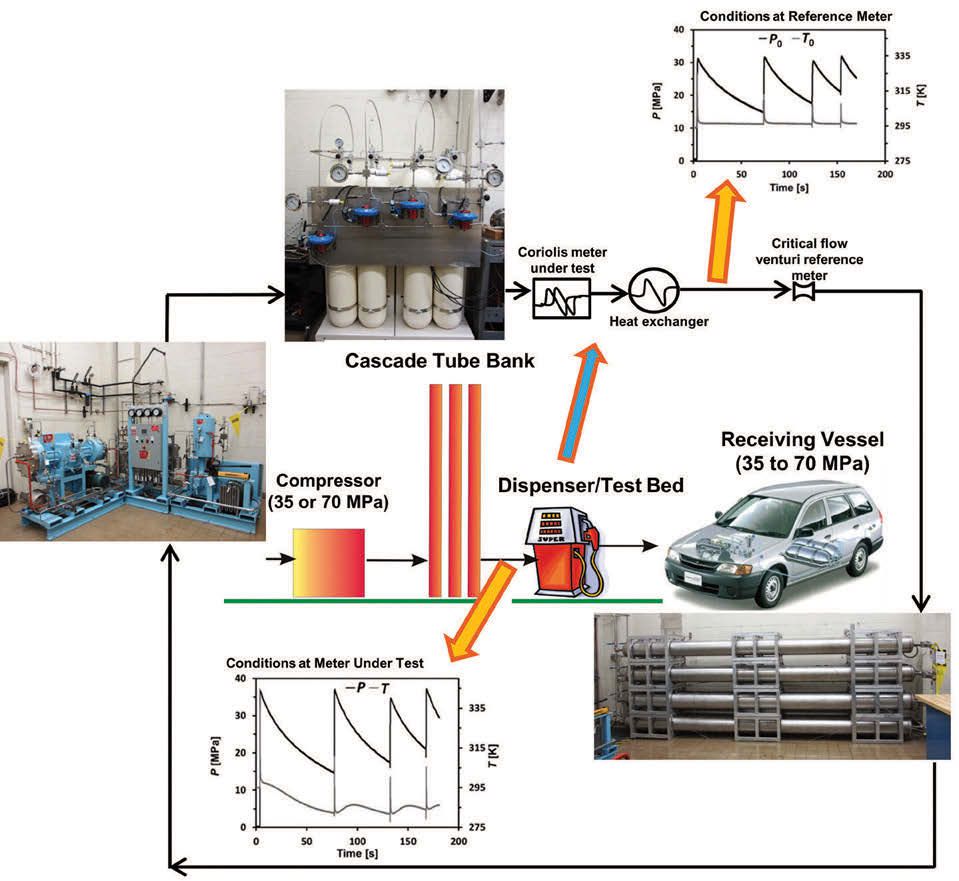Testing meters used to dispense hydrogen fuel
Dr. Neil Canter, Contributing Editor | TLT Tech Beat October 2014
A test-meter facility has been developed for measuring hydrogen gas flow into automobiles.
KEY CONCEPTS
•
Accurately measuring the amount of hydrogen fuel that can be added into a fuel cell-powered automobile is challenging.
•
NIST has developed a transient flow facility (TFF) to evaluate flow meters that can be used in hydrogen-fuel dispensing systems.
•
The capability of two Coriolis meters to accurately measure hydrogen fuel was found to be in agreement with the TFF within 1 percent for totalized mass dispensed measurements.
THE DEMAND FOR AUTOMOBILES that exhibit higher Corporate Average Fuel Economy (CAFE) values and lower emissions profiles is driving technology to develop alternative fuels, leading to the commercialization of hybrid and all-electric vehicles.
Soon another technology will be commercialized—automobiles powered by hydrogen fuel cells. Fuel cells generate no emissions because they generate energy by reacting hydrogen and oxygen to produce water.
One of the problems in developing fuel cells is to find a durable catalyst. The favored catalyst is platinum because of superior performance. A previous TLT article discussed research on a new catalyst containing a monolayer of platinum on palladium nanoparticles (
1). This catalyst lost only 37 percent of its reactivity in testing more than 100,000 cycles, which was a substantial improvement over platinum nanoparticles.
One of the world’s largest automotive manufacturers, Toyota is actively working to develop hydrogen fuel-cell cars (
2). The company will introduce a hydrogen-powered car in Japan before April 2015 and in Europe and North America during the summer of 2015.
A major concern in commercializing hydrogen-powered cars is the low number of fueling stations. According to
Fortune, there are only 180 hydrogen fueling stations in the world, with nine located in California. This state plans to have 21 more hydrogen fueling stations in operation by 2015. Another 38 fueling stations are planned so that California will have the infrastructure to handle 10,000 fuel-cell vehicles.
One of the challenges in using hydrogen is to accurately measure the amount of this fuel as it is dispensed into an automobile. Dr. Jodie Pope, mechanical engineer, Fluid Metrology Group, Sensor Science Division at the National Institute of Standards and Technology (NIST) in Gaithersburg, Md., says, “Gaseous refueling stations have large pressure and temperature gradients that must be accounted for to accurately measure the hydrogen delivered to the vehicle’s tank. To ensure that customers get the fuel they pay for, the hydrogen dispenser should be tested in the field, much as gasoline dispensers are tested today.”
Juana Williams, weights and measures expert at NIST, adds, “From a weights and measures standpoint, a hydrogen fueling station’s entire commercial refueling system needs to be inspected and tested to legal metrology requirements, where applicable. The system must be evaluated and approved for commercial use, then routinely tested while in use by state and local regulatory officials. Given the additional operational variables encountered when dispensing compressed gas vehicle fuel (higher pressure, range of flow rates, typical use, etc.) and influences from environmental conditions, consideration is given to safety, availability of a field test standard and its traceability to national standards, cost effectiveness and portability.”
TRANSIENT FLOW FACILITY
The development of a facility to test meters under conditions close to what are seen in a hydrogen fueling station is an important step toward the goal of having a way to measure hydrogen gas flow into an automobile. Such a test facility has now been developed.
Pope and her associate, John Wright, have developed a test facility for evaluating flow meters that could be used in hydrogen-fuel dispensing systems. The facility is known as the transient flow facility (TFF).
Pope says, “Our TFF can test meters under pressure and temperature transients that would occur from a 35 megapascal (MPa) gaseous dispenser without any gas precooling. This facility was built to test meters for suitability in gaseous dispensers.”
Figure 3 shows a schematic of the TFF. The facility is capable of handling any type of inert gas, which is stored in four, 40-liter tanks pressurized to 42 MPa. These high-pressure tanks can be sequentially discharged to mimic a gaseous refueling dispenser. The TFF can discharge 3 kg of helium in three minutes through the meter under test and the facility’s flow reference. The discharged gas is collected into eight, low-pressure tanks that can each store 250 liters (
shown on the bottom right of Figure 3). The gas is recompressed into the four, 40-liter, high-pressure tanks by a three-stage diaphragm compressor (
shown on the left of Figure 3).
 Figure 3. This schematic shows how the transient flow facility (TFF) is used to assess the accuracy of flow meters that can be used in hydrogen-fuel dispensing systems. (Courtesy of NIST)
Figure 3. This schematic shows how the transient flow facility (TFF) is used to assess the accuracy of flow meters that can be used in hydrogen-fuel dispensing systems. (Courtesy of NIST)
In a recently published study, NIST evaluated the capability of two Coriolis meters to accurately measure the gas dispensed (
3). For the purposes of the study, helium and nitrogen were used in the evaluation process. Pope says, “These surrogate gases were used instead of hydrogen because of the expense of modifying our lab space to safely use hydrogen.”
Helium better simulates hydrogen from a thermodynamic standpoint, according to Pope. The TFF uses fast and slow sensors, in combination with a highly accurate critical flow venture, to evaluate meters. Pope says, “Fast sensors drift and need to have their zero and gain checked periodically. The slow sensors are highly accurate ones that are used to check the fast ones. The fast sensors are necessary to measure fast transient flows when we use the TFF.”
The results from the study protocol showed that the Coriolis meters agreed with the TFF within 1 percent for totalized mass dispensed measurements. This figure is within the tolerance recommended by NIST Handbook (HB) 44 for a dispensing system’s performance, which is 1.5 percent. Therefore, this study is indicative that gaseous dispensers can be designed to meet this tolerance.
Using the TFF as a high-pressure gas source, NIST also has developed and validated, using helium gas, a hydrogen field test standard to evaluate the accuracy of hydrogen dispensers at current refueling stations. The hydrogen field test standard is a portable facility capable of measuring the accuracy of gaseous dispensers via three different test methods. Williams says, “We intend to deploy the field test standard to complete the field test phase of the joint Fluid Metrology Group and Office of Weights and Measures project to refine the three test methods currently recognized in NIST HB 44 for testing the accuracy of a hydrogen gas refueling dispenser.” This field test standard will be used for proof of concept and to aid in developing commercial standards that can be used by state inspectors.
Additional information on the TFF can also be obtained by contacting Pope at
jodie.pope@nist.gov.
REFERENCES
1.
Canter, N. (2011), “Stable fuel cell catalyst,” TLT,
67 (2), pp. 12-13.
2.
See
here.
3.
Pope, J. and Wright. J. (2014), “Performance of Coriolis Meters in Transient Gas Flows,”
Flow Measurement & Instrumentation,
37, pp. 42-53.
 Neil Canter heads his own consulting company, Chemical Solutions, in Willow Grove, Pa. Ideas for Tech Beat items can be sent to him at neilcanter@comcast.net
Neil Canter heads his own consulting company, Chemical Solutions, in Willow Grove, Pa. Ideas for Tech Beat items can be sent to him at neilcanter@comcast.net.